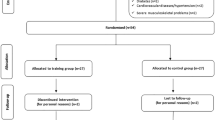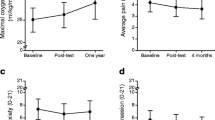Abstract
The aim of the present controlled study was to evaluate the effect of a general fitness program, performed by an occupational health service, using pre-post assessment for a number of different outcome measures. A total of 160 employees working in the central home care service district of Umeå, Sweden were asked to participate in a program of a 1-year long exercise program. Of the 160 selected, 54 subjects declined to participate and nine subjects were rejected after a medical check up. The remaining 97 subjects participated in a schedule consisting of pre-post medical and physiotherapy examinations, questionnaires concerning sociodemography, musculoskeletal and general health complaints and work environment, physiological tests of cardiovascular fitness, and of strength and endurance of shoulder flexors and knee extensors, and registration of sick leave. The subjects were randomly assigned to an exercise (treatment) or control group. The exercise group trained twice a week for 1 year using a mixed program including exercises for coordination, strength/endurance, and fitness. The test schedule was repeated for both groups after 1 year. The exercise intervention was associated with positive changes in prevalence and intensity of musculoskeletal and psychosomatic complaints, better physiotherapy status (less muscle tightness, better neck mobility, and less tender points), increased shoulder strength and increased coordination in thigh muscles. However, the exercise group reported worse situations post-exercise concerning aspects of their physical and psychosocial work-environment (i.e., concerning ergonomy, influence, appreciation and communication with work manager), which might have been due to stress associated with the exercise situation.
Similar content being viewed by others
References
Bergenudd H, Nilsson B. Back pain in middle age; occupational workload and psychologic factors: An epidemiological survey. Spine 1988; 13: 58–60.
Helliwell PS, Mumford DB, Smeathers JE, Wright V. Work related upper limb disorder: The relationship between pain, cumulative load, disability, and psychological factors. Ann Rheum Dis 1992; 51: 1325–1329.
Holmström EB, Lindell J, Moritz U. Low back and neck/shoulder pain in construction workers: Occupational workload and psychosocial risk factors. Part 1: Relationship to low back pain. Spine 1992; 17: 661–671.
Jonsson BG, Persson J, Kilbom A. Disorders of the cervicobrachial region among female workers in the electronics industry. A two-year follow up. Int J lndust Ergon 1988; 3: 1–12.
Stock SR. Workplace ergonomic factors and the development of musculoskeletal disorders of the neck and upper limbs: A meta-analysis. Am J Indust Med 1991; 19: 87–107.
Brisson C, Vinet A, Vézina M, Gingras S. Effect of duration of employment in piecework on severe disability among female garment workers. Scand J Work Environ Health 1989; 15: 329–334.
Flodmark BT, Aase G. Musculoskeletal symptoms and type A behavior in blue collar workers. Brit J Indust Med 1992; 49: 683–687.
Viikari-Juntura E, Vuori J, Silverstein BA, Kalimo R, Kuosma E, Videman T. A life-long prospective study on the role of psychosocial factors in neck-shoulder and low-back pain. Spine 1991; 16: 1056–1061.
Westgaard RH, Jansen T. Individual and work-related factors associated with symptoms of musculoskeletal complaints. II. Different risk factors among sewing machine operators. Brit J Indust Med 1992; 49: 154–162.
Bigos SJ, Battié MC, Spengler DM, Fisher LD, Fordyce WE, Hansson T, Nachemson A, Zeh J. A longitudinal prospective study of industrial back injury reporting. Clin Orthop Rel Res 1992; 279: 21–34.
Bigos SJ, Battié MC, Spengler DM. A prospective study of work perception and psychosocial factors affecting the report of back injury. Spine 1991; 16: 1–6.
Holmström EB, Lindell J, Moritz U. Low back and neck/shoulder pain in construction workers: Occupational workload and psychosocial risk factors. Part 2: Relationship to neck and shoulder pain. Spine 1992; 17: 672–677.
Theorell T, Harms-Ringdahl K., Ahlberg-Hultén G, Westin B. Psychosocial job factors and symptoms from the locomotor system — a multicausal analysis. Scand J Rehab Med 1991; 23: 165–173.
Tola S, Riihimäki H, Videman T, Viikari-Juntura E, Hänninen K. Neck and shoulder symptoms among men in machine operating, dynamic physical work and sedentary work. Scand J Work Environ Health 1988; 14: 299–305.
Kilbom Å, Hagberg M. Work-related musculoskeletal diseases — high risk jobs and risk factors (in Swedish). Arbete & Hälsa 1990; 19: 45.
Cady LD, Bischoff DP, O'Connell ER, Thomas PC, Allan JH. Strength and fitness and subsequent back injuries in fire fighters. J Occup Med 1979; 21: 269–272.
Battié MC, Bigos SJ, Fisher LD, Hansson TH, Nachemson AL, Spengler DM, Wortley MD, Zeh J. A prospective study of the role of cardiovascular risk factors and fitness in industrial back pain complaints. Spine 1989; 14: 141–147.
Battié MC, Bigos SJ, Fisher LD, Hansson TH, Jones ME, Wortley MD. Isometric lifting strength a predictor of industrial back pain reports. Spine 1989; 14: 851–856.
Battié MC. The Reliability of Physical Factors as Predictors of the Occurrence of Back Pain Reports. A Prospective Study Within Industry. Medical dissertation, Gothenburg, Sweden, 1989.
Gyntelberg F. One-year incidence of low back pain among male residents of Copenhagen aged 40–59. Danish Med Bull 1974; 21: 30–36.
Mostardi RA, Noe DA, Kovacik MW, Porterfield JA. Isokinetic lifting strength and occupational injury — a prospective study. Spine 1992; 17: 189–193.
Troup JDG, Foreman TK, Baxter CE, Brown D. The perception of back pain and the role of psychophysical tests of lifting capacity. Spine 1987; 12: 645–657.
Frymoyer JW, Cats-Baril W. Predictors of low back pain disability. Clin Orthop Rel Res 1987; 221: 89–98.
Gerdle B, Edlund C, Bylund SE, Jönsson E, Sundelin G. Complaints officially confirmed as occupational disorders in Västerbotten (Sweden) over a 2-year period (in Swedish). Arbete & Hälsa 1989; 23.
Kourinka I, Jonsson B, Kilbom Å, Vinterberg H, Biefing-Sørensen F, Andersson G, Jørgensen K. Standardized nordic questionnaires for the analysis of musculoskeletal symptoms. Appl Ergon 1987; 18: 233.
Elert, J, Rantapää-Dahlqvist SB, Henriksson-Larsén K, Lorentzon R, Gerdle B. Muscle performance, electromyography and fibre type composition in fibromyalgia and work-related myalgia. Scand J Rheumatol 1992; 21: 28–34.
Elert J, Brulin C, Gerdle B, Johansson H. Mechanical performance, level of continuous contraction and muscle pain symptoms in home care personnel. Scand J Rehab Med 1992; 24: 141–150.
Elert J. The pattern of activation and relaxation during fatiguing isokinetie contractions in subjects with and without muscle pain. Arbete & Hälsa 1991; 47.
Gerdle B, Brulin C, Elert J, Granlund BM. Factors interacting with perceived work-related complaints in the musculoskeletal system among home care service personnel — an explorative multivariate study. Scand J Rehab Med (in press).
Kellet KM, Kellet DA, Nordholm LA. Effects of an exercise program on sick leave due to back pain. Phys Ther 1991; 71: 283–291.
Gundewall B, Liljeqvist M, Hansson T. Primary prevention of back symptoms and absence from work. Spine 1993; 8: 587–594.
Mayer T, Gatchel R, Kishino N. Objective assessment of spine function following industrial injury. Spine 1985; 10: 482–483.
Manniche C, Hesseløe G, Bentzen L, Christensen I, Lundberg E. Clinical trial of intensive muscle training for chronic lowback pain. Lancet 1988; 31: 1473–1476.
Manniche C, Lundberg E, Christensen I, Bentzen L, Hesseløe G. Intense dynamic back exercises for chronic low back pain: A clinical trial. Pain 1991; 47: 53–63.
Risch SV, Norvell NK, Pollock ML, Risch ED, Langer H, Fulton M, Graves JE, Leggett SH. Lumbar strengthening in chronic low back patients — physiological and psychological benefits. Spine 1993; 18: 232–238.
Dyrssen T, Svedenkrans M, Paasikivi J. Muskelträining vid besväir i nacke och skuldror — efffektiv behandling för att minska smärtan. Sjukgymnasten 1989; 10: 12–15.
Wigeus-Hjelm E, Hagberg M. Prevention of musculoskeletal disorders in nursing aides. A randomized study of physical training. In: Hagberg M, Kilbom A, eds. Proceedings from the International Scientific Conference on Prevention of Work-Related Musculoskeletal Disorders. Arbete & Hälsa 1992; 17: 338–340.
Block AR. Multidisciplinary treatment of chronic low back pain: A review. Rehab Psych 1982; 27: 51–63.
Bono SF, Zasa ML. Chronic low back pain and therapy: A critical review and overview. Behav Ther 1988; 11: 189–198.
Kilbom A. Isometric strength and occupational muscle disorders. Eur J Appl Physiol 1988; 57: 322–326.
Nordin M, Crites-Battié M, Pope MH, Snook S. Education and training. In: Pope MH, Andersson GBJ, Frymoyer JW, Chaffin DB, eds. Occupational low back pain. Assessment, treatment and prevention. St. Louis: Mosby Yearbook, 1991, pp. 266–276.
Biering-Sørensen F. Physical measurements as risk factors for low back trouble over a one year period. Spine 1984; 9: 106–119.
Biering-Sørenson F, Thomsen CE, Hilden J. Risk indicators for low back trouble. Scand J Rehab Med 1989; 21: 151–157.
Andersson, G. The Importance of Exercise for Sick Leave and Perceived Health. Linköping University Medical Dissertation No. 245, 1987.
Eide R. The relationship between body-image, self-image and physical activity. Scand J Soc Med 1982; 29: 109–112.
Fasting K. Leisure time, physical activity and some indices of mental health. Scand J Soc Med 1982; 29: 113–119.
Hafström K, Lundqvist M. Exercise during working time — a way to decrease sick-leave among women (in Swedish). Sjukgymnasten 1991; 3: 35–41.
Hughes JR. Psychological effects of habitual aerobic exercise: A critical review. Prevent Med 1987; 13: 66–78.
Härmä MI, Ilmarinen J, Knauth P, Hänninen O. Physical training intervention in female shift workers: 1. The effects of intervention on fitness, fatigue, sleep and psychosomatic symptoms. Ergonomics 1988; 31: 35–50.
Lindström I, Öhlund C, Eek C, Wallin L, Peterson LE, Nachemson A. Mobility, strength and fitness after a graded activity program for patients with subacute low back pain. A randomized prospective clinical study with a behavioral therapy approach. Spine 1992; 17: 641–652.
Addison R, Schultz A. Trunk strengths in patients seeking hospitalization for chronic low-back disorders. Spine 1980; 6: 539–544.
Cassisi JE, Robinson ME, O'Conner P, MacMillan M. Trunk strength and lumbar paraspinal muscle activity during isometric exercise in chronic low-back pain patients and controls. Spine 1993; 18: 245–251.
Jørgensen K, Nicolaisen T. Trunk extensor endurance: Determination and relation to low-back trouble. Ergonomics 1987; 30: 259–267.
Kilbom A. Disorders of the cervicobrachial region among female workers in the electronics industry. Int J lndust Ergon 1986; 1: 37–47.
Kilbom A. Intervention programmes for work-related neck and upper limb disorders: Strategies and evaluation. Ergonomics 1988; 31: 735–747.
Hägg GM, Suurkula J, Kilbom A. Predictors for work related shoulder/neck disorders. A longitudinal study of female assembly workers. Arbete & Hälsa 1990; 10.
Salminen JJ, Pentti J, Wikström G. Tenderness and pain in neck and shoulders in relation to type A behavior. Scand J Rheumatol 1991; 20: 344–350.
Martin JE, Dubbert PM. Adherence to exercise. Exercise Sports Sci Rev 1983; 13: 137–167.
Author information
Authors and Affiliations
Rights and permissions
About this article
Cite this article
Gerdle, B., Brulin, C., Elert, J. et al. Effect of a general fitness program on musculoskeletal symptoms, clinical status, physiological capacity, and perceived work environment among home care service personnel. J Occup Rehab 5, 1–16 (1995). https://doi.org/10.1007/BF02117816
Published:
Issue Date:
DOI: https://doi.org/10.1007/BF02117816




